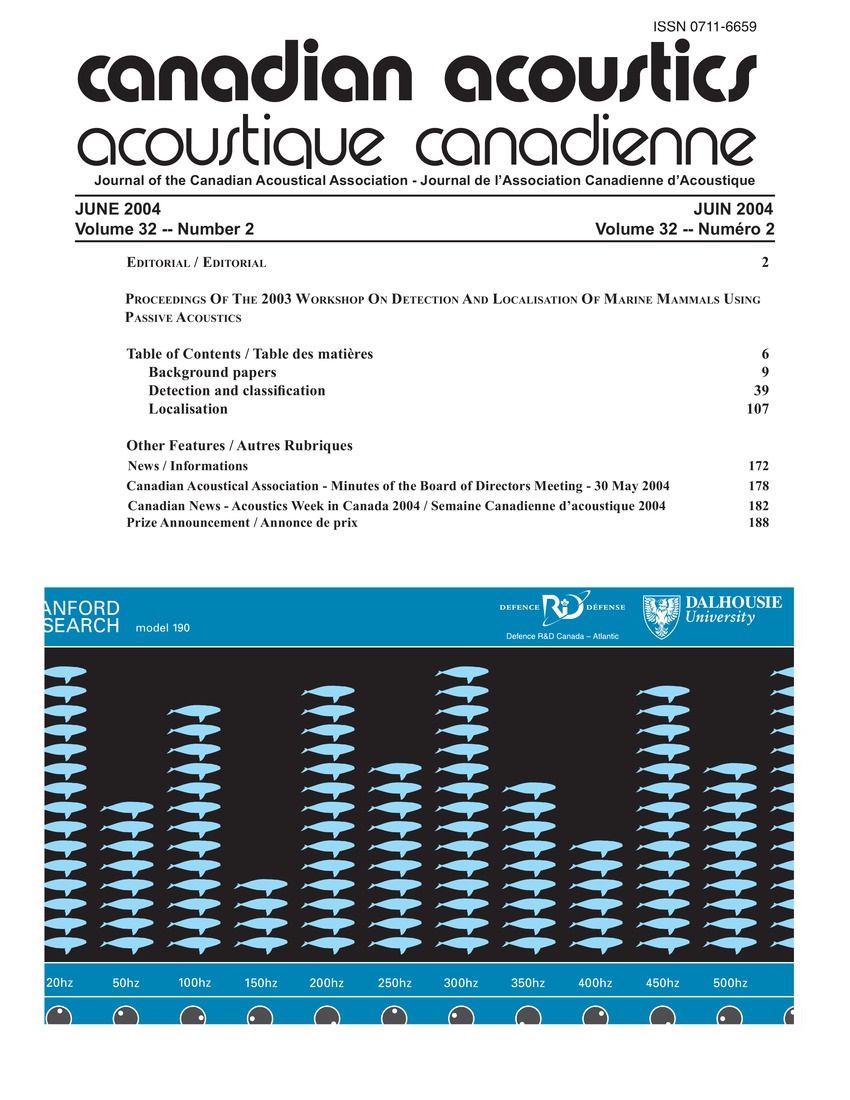Waveguide propagation allows range estimates for north pacific right whales in the bering sea
Keywords:
Acoustic waves, Modal analysis, Parameter estimation, Sediments, Waveform analysis, Waveguides, Acoustic recording, Sediment density, Waveguide propagation, WhalesAbstract
The shallow and uniform water depth of the eastern Bering Sea shelf results in an acoustic waveguide. Propagation within this waveguide produces waveform dispersion which is dependent upon range. We present a means for using dispersed waveforms to determine range to calling whales from a single autonomous acoustic recording instrument. The predominant North Pacific right whale (Eubalaena japonica) call is frequency upswept from about 90 Hz to around 160 Hz and lasts approximately 1 s. The regional bathymetry of the eastern Bering Sea middle shelf is relatively uniform and shallow (?70 meters deep). This geometry provides a plane-layered waveguide in which right whale upswept calls can be detected at ranges over 50 km and have multiple modal arrivals that become dispersed, displaying different propagation velocities for different frequencies. Dispersion characteristics of modal arrivals are dependent on the calling whale's depth, the receiver's depth, the water depth, the range from caller to receiver, and various environmental parameters including water and sediment density and sound velocity. A model of sound propagation for the eastern Bering Sea middle shelf is developed from right whale call dispersion recorded on sonobuoys and seafloor acoustic recording packages, using individual calls recorded at multiple instruments. After development of the model, waveform dispersion allows estimation of caller range based on single instrument recordings. Estimating range between instrument and calling whales provides a means to estimate minimum abundance for the endangered North Pacific right whale.Additional Files
Published
How to Cite
Issue
Section
License
Author Licensing Addendum
This Licensing Addendum ("Addendum") is entered into between the undersigned Author(s) and Canadian Acoustics journal published by the Canadian Acoustical Association (hereinafter referred to as the "Publisher"). The Author(s) and the Publisher agree as follows:
-
Retained Rights: The Author(s) retain(s) the following rights:
- The right to reproduce, distribute, and publicly display the Work on the Author's personal website or the website of the Author's institution.
- The right to use the Work in the Author's teaching activities and presentations.
- The right to include the Work in a compilation for the Author's personal use, not for sale.
-
Grant of License: The Author(s) grant(s) to the Publisher a worldwide exclusive license to publish, reproduce, distribute, and display the Work in Canadian Acoustics and any other formats and media deemed appropriate by the Publisher.
-
Attribution: The Publisher agrees to include proper attribution to the Author(s) in all publications and reproductions of the Work.
-
No Conflict: This Addendum is intended to be in harmony with, and not in conflict with, the terms and conditions of the original agreement entered into between the Author(s) and the Publisher.
-
Copyright Clause: Copyright on articles is held by the Author(s). The corresponding Author has the right to grant on behalf of all Authors and does grant on behalf of all Authors, a worldwide exclusive license to the Publisher and its licensees in perpetuity, in all forms, formats, and media (whether known now or created in the future), including but not limited to the rights to publish, reproduce, distribute, display, store, translate, create adaptations, reprints, include within collections, and create summaries, extracts, and/or abstracts of the Contribution.


